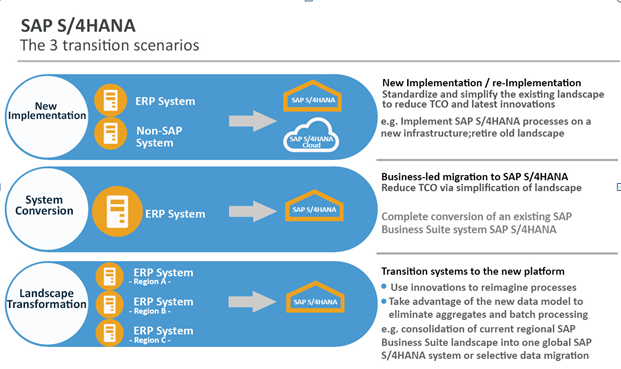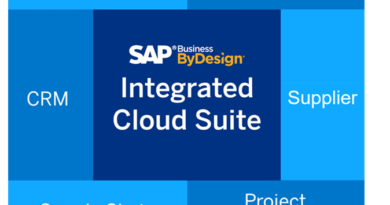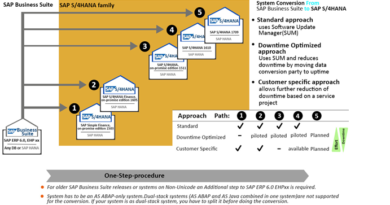Three Paths to the Destination:
Just like SAP Business Suite organizations can select from three possible routes for migration to SAP S/4HANA- landscape transformation, system conversion, and Greenfield implementation. While evaluating the best part of the enterprise the target architecture under consideration is very essential. As mentioned before Enterprises that are already using SAP ERP 6.0 with an improved package and higher can directly migrate to SAP S/4HANA using a system conversion.
Options to adopt S/4HANA:
Going by the reasons and context stated above, the S/4HANA adoption of Enterprise Application with regard to processes is desirable, to say the least. In the future, it may very well be inevitable. Businesses new to SAP can go straight ahead with implementation of S/4 HANA. But enterprises already powered by previous versions and products of SAP will need to get some queries out of the way first.
It is essential that a prospective customer should analyze all options with regard to key parameters and decision factors when it comes to adopting S/4HANA effectively.
System Conversion:
Enterprises already running on SECC), will find that adopting S/4HANA is simple. This is by using the system conversion method. A pre-eAP (xisting SAP ECC instance can be transformed into a S/4HANA instance with all the historical data complete when supported by efficiently documented processes going hand in hand with System conversion tools which are inbuilt. This migration scenario is standard and established and has detailed protocols for execution, including numerous technical steps to reach S/4HANA and steps for code optimization for the Custom code created in the pre-existing system.
New implementation of S/4HANA:
The scenario discussed above is an idealistic one not applicable to most businesses currently in the market. Such enterprises do not have an optimal SAP deployment leading to accumulation of massive amounts of data. In this case, it is best to drop efforts which are too cumbersome and resort to a brand-new S/4HANA implementation.
A new implementation is most often the path of least resistance because of the factors stated below:
Sub-optimal Enterprise Structure:
The most significant part of an SAP implementation is the definition of organizational elements. This is strange as element definition typically occurs at the start of the implementation. And when an implementation begins there usually is no comprehensive understanding of processes involving SAP.
Process controls and reporting structure emanate from an enterprise structure; hence its importance cannot be stressed enough. The true value proposition within Enterprise Structure definitions will reveal themselves only after the system attains a level of maturity. And for a considerable amount of time would have elapsed, making changes at such a later stage becomes problematic at best. In particular, the cases of the original implementation, Enterprise Structure definition will be affected due to the constraints posed by SAP, which may lead to a sub-optimal setup. Brand new functionalities mean some of the older SAP constraints will not pose a problem opening up the scope for a more practical Enterprise Structure definition.
Poor Data Quality:
Another frequent scenario that one can observe is enterprises running on SAP instances face problems with Master Data.
The problem with the quality of Master Data is two-fold:
Inaccurate and sub-par structural definition of Master Data is a major issue. This problem can be from numbering logic for the Material Masters or even the definition of Customer and Vendor Account Groups. Another issue that could be of concern is structuring for Chart of Accounts. This might create inflexibility in fresh business processes and reporting requirements which in turn will lead to restricted businesses by adopting unsound workaround solutions or buggy permanent fixes.
The lack of governance of Master Data:
Several instances can be observed with the unmonitored generation of Master data prior to the installation of a proper governance system and policy. This means data duplication and an unwanted accumulation of unneeded data in the system, leading to inaccurate processing of transactions. This might also create problems with regard to inefficiency resulting from confusion. Such a scenario will also call for a fresh implementation.
SAP has not fully leveraged: Many reasons contribute to a lesser than full utilization of SAP features and functionalities:
- Business needs have changed considerably over time, but the ERP dealing with the corresponding needs has not evolved in time due to reasons of insufficient time, budget or other resources keeping enterprises from updating to suit modern IT landscapes.
- An idealistic and original implementation of SAP is bound to be simplistic and not flexible enough to adapt to volatile market scenarios which have become common place with exponential developments in IT. The full potential of SAP systems can only be harnessed with the aid of a customized implementation.
- Insufficient competency in particular topics such as Materials Planning Credit Management, Cash Discounts, Rebate processing, Actual Costing, etc. Leads to poor data for these processes, therefore, making these processes either redundant or leading to complete elimination.
High level of Custom developments:
Many scenarios see processes out of alignment with standardized best practices. This will lead to the re-introduction of older and outdated processes through the original SAP implementation. Therefore, there will be a larger number of custom developments, which will be responsible for running mission-critical business processes. When you incorporate a high degree of customizations it might lead to some problems as mentioned below:
- Insufficient flexibility to adapt to changes is a possible hassle since every change that has to be implemented will have associated costs and segregated and distinct efforts and resources.
- Heavy maintenance might result since a highly customized environment necessitates a whole sub-department for its periodic maintenance and troubleshooting hence choking the resources and bottom line of the enterprise.
- Inability to harness new innovations is also a byproduct of high customizations since businesses don’t adopt the standard processes frequently in this case, missing out on key innovations that are expected in the standard processes.
- In such an environment, the movement to S/4HANA presents a good opportunity to have a re-look at the customization done and adapt to standard best practices through a fresh and new implementation.
Multi-system & multi-application environment:
Massive businesses have a tendency to create a complicated and interconnected network of systems and applications for core enterprise processes. Such a complex network of systems may be a result of custom-made applications or as a result of joint ventures between companies and acquisitions and mergers. In such instances, the enterprise will have to deal with an overly complicated network of applications and Systems which will need to be interfaced. Therefore, a thorough simplification of a landscape in terms of applications and systems becomes necessary. This is when you will have to consider the journey to S/4HANA which presents an amazing opportunity to rehash the system and application landscape and simplify the same. This will again require a brand-new implementation of SAP S/4HANA.
S4HANA_Migration Scenarios
System Conversion:
System conversions to SAP S/4HANA will retain the actual system ID for customization, interface, authorizations, data, and development. This is otherwise called an in-place migration. Systems which are powered by SAP ERP 6.0 using enhancement package and higher can undergo migration to SAP S/4HANA directly without the need for upgrading to an enhancement package which is higher. This is based on the assumption that the system is previously a Unicode system. After the release of SAP NetWeaver 7.5, SAP is set to support only Unicode systems. If an enterprise system is not Unicode, it has to be converted into Unicode prior to the conversion. The system conversion to SAP S/4HANA is added by SUM-DMO which is the software update manager with the data migration option. This will support enterprises in upgrading and migrating database is in a single step, eliminating massive amounts of downtime.





Geciktirici Sprey Nedir? Kullanımı oldukça kolay olan geciktirici spreyler partnerlerin ilişki esnasında fiziksel açıdan doyuma ulaşmasını sağlar.En İyi Geciktirici Sprey · Black Berry Geciktirici Sprey 25 ml · BayCazip 2adet Geçiktiriçi Erkeklere Ozelstağ Sprey Resımdekının Aynısı Gelır STAG 9000 ERKEKLERE ÖZEL GELİŞTİRİLMİŞTİR. ERKEN BOŞALMA PROBLEMİ YAŞAYAN KİŞİLERDE uygulanması tavsye edilir. GÜÇLÜ FORMULÜ SAYESİNDE GECİKTİRİREK Geciktirici spreyler penisin uç kısmına gelecek şekilde sıkılır ve bölgeyi biraz uyuşturarak ereksiyonu uzatır.Geciktirici Sprey n11.com’da. Geciktirici Sprey modelleri, geciktirici sprey markaları, seçenekleri, özellikleri ve en uygun fiyatları Geciktirici Sprey – Sprey Boya ve Yapı Malzemeleri uygun fiyatlarla ilan ve alışverişte ilk adres https://libidoxa.com/libidoxa-premium-delay-geciktirici-sprey